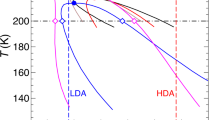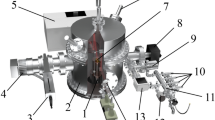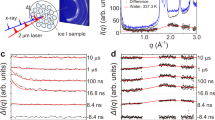Abstract
IT is well known that if a supercooled liquid is exposed to ionizing radiation the probability of homogeneous freezing in it increases1–3. A plausible explanation for this is that there always exist in a liquid fluctuational density variations, and at some places molecules coming close to each other form a compact microsystem—a quasi-crystallite—of a very short lifetime. The probability of formation of such quasi-crystallites increases with a lowering of temperature. In the supercooled state of a liquid this probability is large enough to render the liquid metastable with regard to freezing. These crystallites thus play the part of “embryos” for crystal growth in the liquid. The change in the Gibbs free energy for embryo formation and the molecular density variations in the liquid are then the factors which decide whether, in certain given conditions, the nucleation will take place. It can be shown that ionization significantly improves the condition for nucleation. Detailed theory for this has been worked out by us4 and independently by Pisarev5.
This is a preview of subscription content, access via your institution
Access options
Subscribe to this journal
Receive 51 print issues and online access
$199.00 per year
only $3.90 per issue
Buy this article
- Purchase on Springer Link
- Instant access to full article PDF
Prices may be subject to local taxes which are calculated during checkout
Similar content being viewed by others
References
Frischauer, L., CR Acad. Sci., Paris, 148, 1251 (1909).
Bolshanina, M. A., and Kuznetsov, V. D., Zh. Russ. Fiziko Khimicheskovo Obschestva, 57, 15 (1925).
Varshneya, N. C., Roorkee (India) Univ. Res. J., 8, 1 (1965).
Varshneya, N. C., Proc. Symp. on Cosmic Rays, Elementary Particle Physics and Astrophysics, Aligarh (India) 1967, 96 (Department of Atomic Energy, Government of India).
Pisarev, A. F., Zh. Eksp. Teoret. Fiz., 54, 463 (1968).
Author information
Authors and Affiliations
Rights and permissions
About this article
Cite this article
VARSHNEYA, N. Detecting Radiation with a Supercooled Liquid. Nature 223, 826–827 (1969). https://doi.org/10.1038/223826a0
Received:
Revised:
Issue Date:
DOI: https://doi.org/10.1038/223826a0
This article is cited by
Comments
By submitting a comment you agree to abide by our Terms and Community Guidelines. If you find something abusive or that does not comply with our terms or guidelines please flag it as inappropriate.



